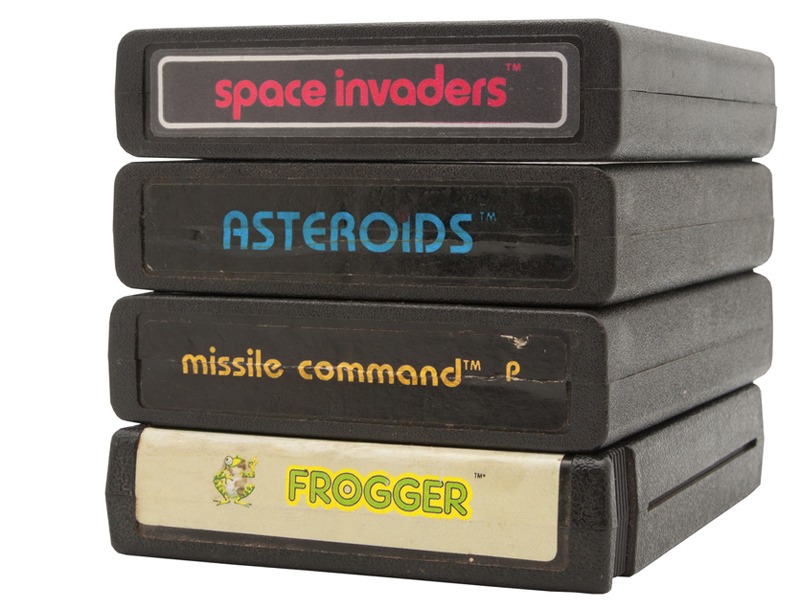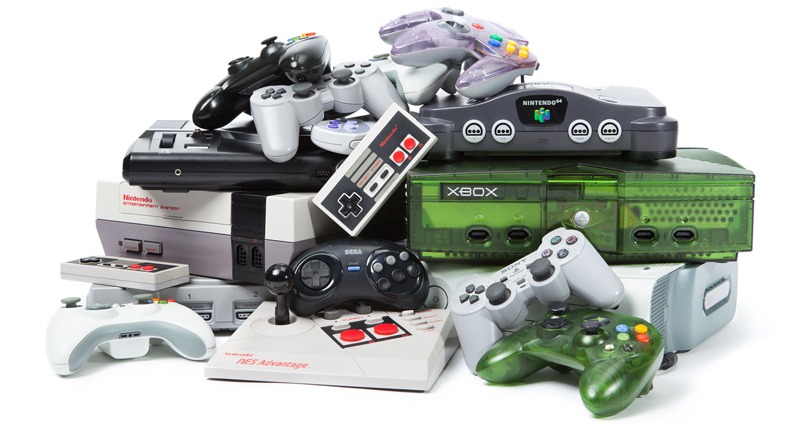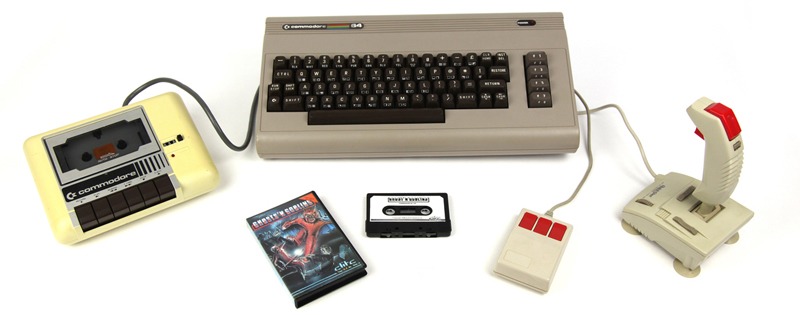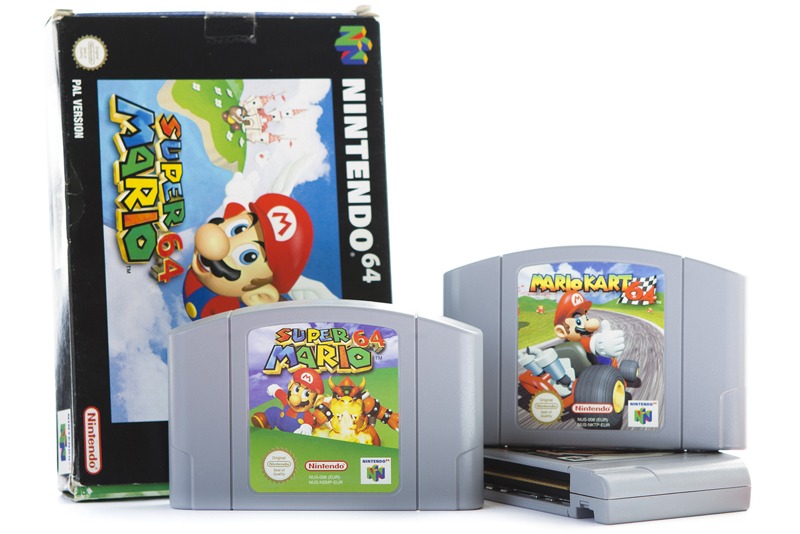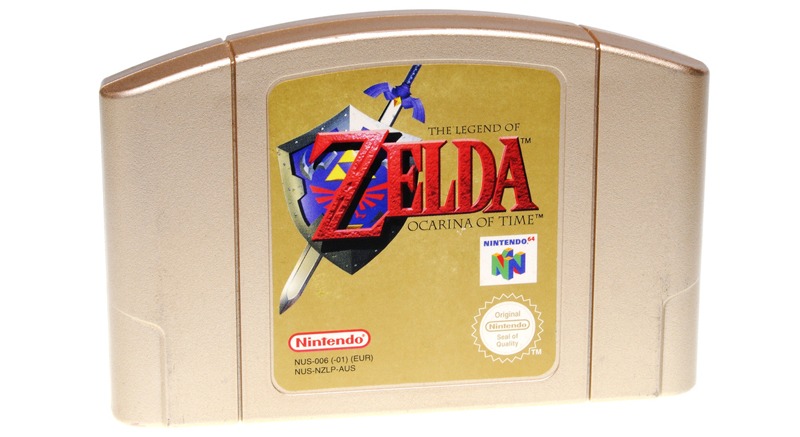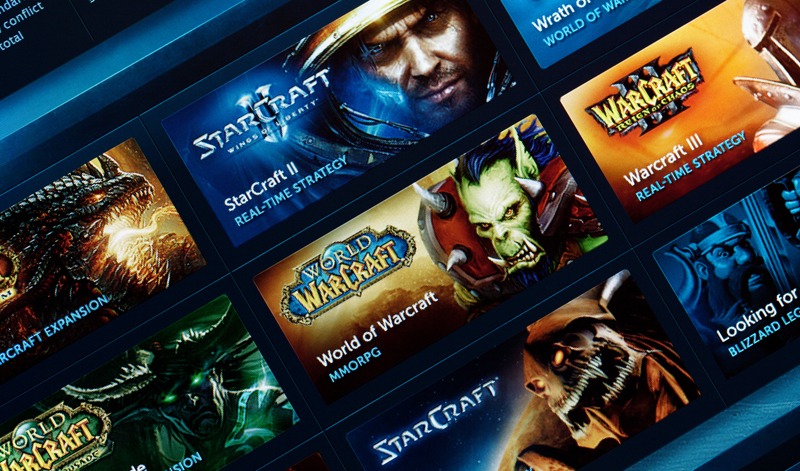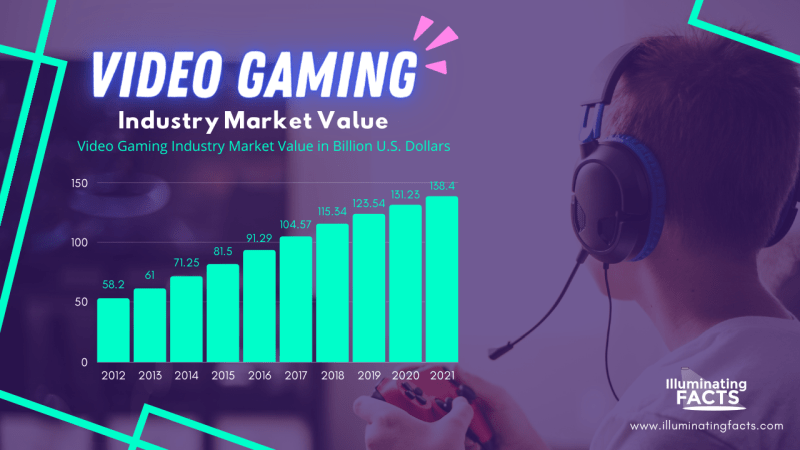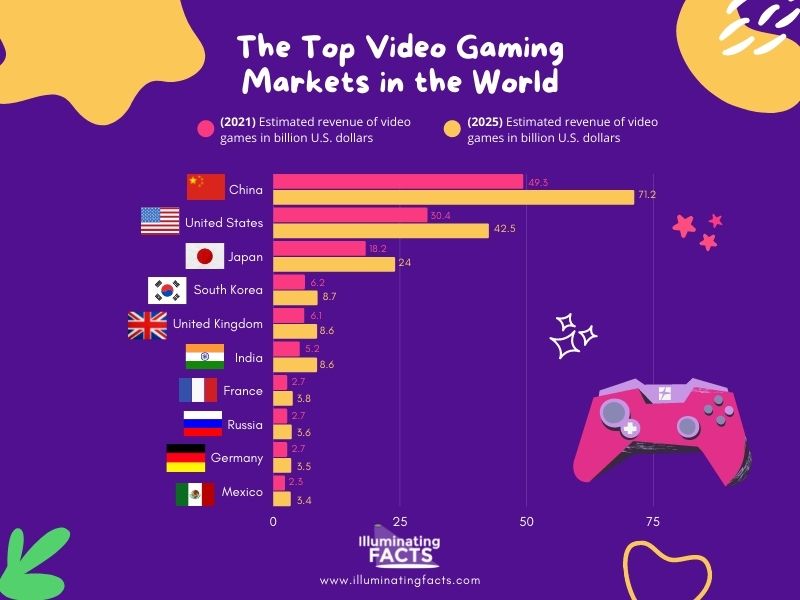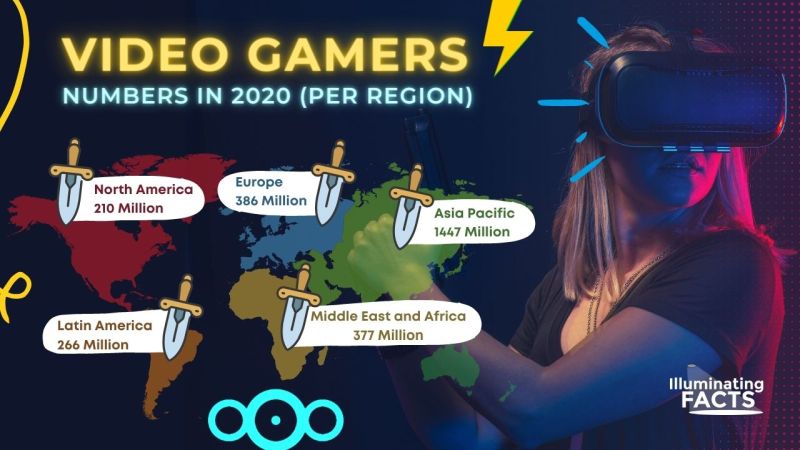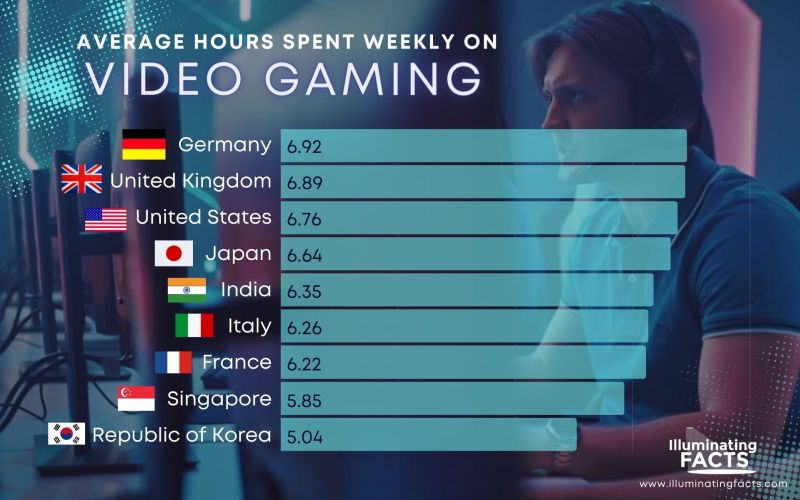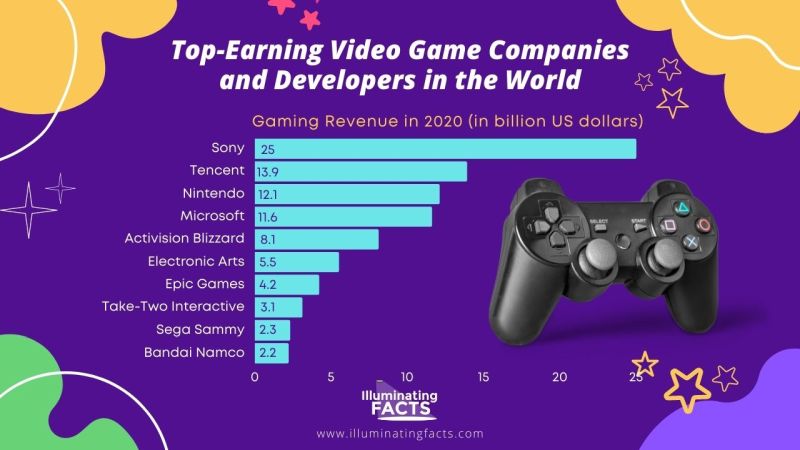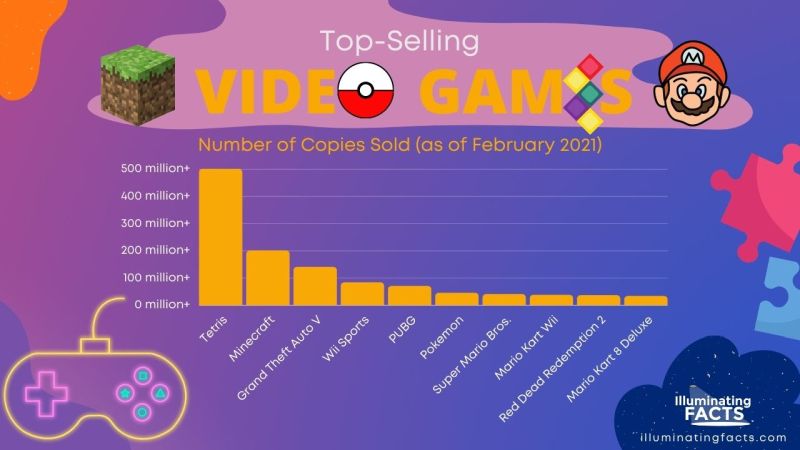Background
When you ask people about their favorite pastime or hobby, video gaming is one of the many answers you will hear. Video games are digitally based games that are usually played using dedicated gaming devices, such as game consoles, personal computers, or handheld game devices. Before, people played video games simply for entertainment purposes, for fun, and to bond with family and friends. However, as time passes, the video game industry is continuously changing. Aside from playing video games as a hobby, many people today are also playing to earn money.
At the present time, there are more video game players. With this, video game developers are also constantly making and re-making video games, making the industry very successful. Today, video games make up a $100 billion global industry, and about two-thirds of homes in America have household members who regularly play video games. If you want to learn more about video games, this post is perfect for you.
This post will tackle video game history, the invention of different video game consoles and devices, and the various video game genres. In addition, we will show you video games in numbers, such as the market value of the video game industry, the growth of video game players, the top-selling video game genres, the top-earning video game developers, and the top-selling video games of all time. All of these include graphs, charts, and infographics about video games through the years.
History
The video gaming industry is one of the most profitable among the many different entertainment industries in the world. More so, when mobile technology became successful in recent years, it opened doors to a new generation of gamers.[1] But before video gaming became a successful industry, it had its humble beginnings and a fair share of ups and downs. Let’s take a look into the history of video games.
The Early Years of Video Gaming
While video games are mostly played today in homes in different parts of the world, did you know that they began in the research lab of scientists many years back?
When people talk about the first video game invented, many would say that it was Pong, a game released by Atari. However, the first real video game ever created was by William Higinbotham in 1958, and it was called Tennis for Two.[2] The game was created on a big analog computer. An oscilloscope screen was connected to it, as it was presented on the annual visitor’s day at the Brookhaven National Laboratory in Upton, New York.[3]
However, like many in history, Higinbotham did not fully grasp the implication of his venture into video gaming. His invention was then followed by a game developed by Steve Russel in 1962 called “Spacewar!”.[2] The game was developed at the Massachusetts Institute of Technology. It was a computer-based space combat video game for the Programmed Data Processor-1 or PDP-1.
“Spacewar!” was the first video game that could be played on several computer installations.[3] The game involved two players that faced off in an intense dogfight. Each player controlled either the wedge or the needle. It involved gravity effects and faster-than-light travel.[2] This game was made in the ‘60s, but it sounds like a modern-day game, right?
The Emergence of the Home Console
Currently, playing video games is done using computers, mobile devices, and modern gaming consoles, such as Xbox and PlayStation. But have you ever thought about what the first gaming console was?
Back in 1967, Ralph Baer and other developers at Sanders Associates, Inc. created a prototype multiplayer, multi-program video game system that could be connected and played on a television. They called it “The Brown Box.” Baer was often referred to as the Father of Video Games. After creating the console, it was licensed to Magnavox, which sold the gaming system to consumers as the “Odyssey.” [3] The Magnavox Odyssey was the very first video game home console, and it was released in 1972.[2] However, over the next few years, the Odyssey console eventually ended.
The Odyssey had 28 games, and one of those games was the inspiration for the creation of “Pong” by Atari. It was the first arcade video game that was released in 1972. When 1975 came, Atari released a home version of the game, which also became as successful as its arcade equal. However, Sanders Associates and Magnavox sued Atari for copyright infringement. It was settled by Atari and became an Odyssey licensee. In the next 20 years, Magnavox won more than $100 million in copyright grievances that were correlated to the Odyssey and its video game patents.[3]
The Atari 2600 was released by Atari in 1977, which was also called the Video Computer system. It was a home console that had joysticks and interchangeable game cartridges. The Atari 2006 played multi-colored games, which kicked off the second generation of video game consoles.[3]
The Popularity of Arcade Video Games
In the late 1970s and early 1980s, an impressive boom in the popularity of arcade games happened, which brought serious commercial success. In 1987, the “Space Invaders” game was released, marking a new dawn for games. “Space Invaders” was a simple but very addictive game wherein the player plays a lone gunner ship at the bottom of the screen. The top half featured space invaders intruding on the player. They increase in speed as their numbers decline.[2]
After the popularity of “Space Invaders.” Another game was introduced, which was “Pac-Man.” If you don’t know this game, you need to navigate through a maze without dead ends on each level, eating all the white dots and fruits for points. As you do this, you are chased by ghosts in different colors. Therefore, the goal is to eat as many dots and fruits as possible while avoiding or defeating the ghosts.[2] The game became an international hit, and many spin-offs were made, including “Ms. Pac-Man.”
The Fall of the Video Game Industry
After the invention of the games mentioned earlier, there were many others that followed. These include Nintendo’s creation of “Donkey Kong,” which was the game that introduced the now-famous character Mario. In addition to that, the first Flight Simulator game from Microsoft was also released.
However, as revolutionary as those home console and arcade games were, the gaming industry still faced a crisis.[2] Back in 1983, a major crash was experienced by the North American video game industry due to different issues, such as competition from computer gaming, an oversaturated market of game consoles, and an excess of over-hyped but low-quality games. The fall of the video game industry lasted for two years, leading to the bankruptcy of many home computer and video game console companies.[3]
From 1983 to 1984, many other gaming options seemed to defeat arcade games. With this, there were more than 15,000 closures of arcades. An urban legend says Atari had all of their remaining copies of the E.T. game that were buried in a New Mexico landfill.[2]
The Recovery of the Video Game Industry
When 1985 came, the video game home industry started to recover. It was during the time when Nintendo Entertainment System or NES, which was called Famicom in Japan, came to the United States. The console had improved 8-bit graphics, sound, colors, and gameplay compared to the previous consoles that were released. Nintendo is a Japanese company founded in 1889. It is among the most popular video game companies today, which released many important video game franchises, such as “Metroid,” “The Legend of Zelda,” and “Super Mario Bros.” [3]
The NES was the best-selling video game console from 1985 to 1995. Some of the first game releases included “Popeye,” “Donkey Kong,” and “Donkey Kong, Jr.,” to name a few. In addition to that, it was also a revolutionary game console due to its multiple accessories inclusions, which enhanced the gameplay.[2]
Nintendo also imposed different regulations when it comes to third-party games that were developed for its system. These guidelines helped combat low-quality and rushed software. Some of the long-lasting franchises that third-party developers released include “Castlevania” by Konami, “Mega Man” by Capcom, “Final Fantasy” by Square, and “Dragon Quest” by Enix. (It was in 2003 when Square and Enix merged and formed Square Enix.)
Once again, Nintendo made waves by popularizing handheld gaming in 1989. It released the 8-bit Game Boy video game device along with the game “Tetris.” This was followed by many successful successors in the next years, such as the Game Boy color in 1998, Game Boy Advance in 2001, Nintendo DS in 2004, and Nintendo 3Ds in 2011.[3]
The First Competitions Between Video Game Consoles
Since the time consoles began to gain popularity and appeared in households around the world, they also formed a special place in the hearts of many people who played them. In fact, some people loved them so much that they started to identify with these consoles personally. This is why when there are competitions for their beloved console, it metaphorically becomes a declaration of war. While console wars still exist today, let us look at the first console war from years ago.
Back in 1989, Nintendo was at the peak of the gaming market. It had the newly released Game Boy during that time, and it was quite challenging to think how anyone could compete with the company’s dominance in video games. However, in the same year, the first real competition arose when Sega released the 16-bit Sega Genesis.[4]
The Sega Genesis was superior to the NES. Along with that were clever marketing and the release of the “Sonic the Hedgehog” game in 1991, which made significant headway against Nintendo. When 1991 came, Nintendo released the 16-bit Super NES console in North America, launching the first-ever “console war.” [3]
Both Nintendo and Sega released many successful games on their consoles, including “Mortal Kombat” and “Street Fighter.” However, in response to the violent game, in 1993, Sega created the Videogame Rating Council, which provided descriptive labeling for every game sold on the Sega home console. Later, the council made the industry-wide Entertainment Software Rating Board that is still being used today to classify video games based on their content.[3]
After the console wars between Nintendo and Sega, a new challenger, Sony, appeared. This started after a failed agreement between Nintendo and Sony to create a CD-ROM addition to the SNES, which left both of them not on the greatest of terms. In 1995, Sony released the PlayStation. Due to its lower price and revolutionary 3D graphics, it had a significant advantage over its competitors.[4]
In 1996, Nintendo released another console, which is the Nintendo 64, which can accommodate four controllers for multiplayer games. However, even though it was more successful than Sega’s newest Saturn console, the PlayStation still won the console war, which became the first console to surpass 100 million units sold. This was due to the huge variety of game titles available. Even though the Nintendo 64 had some of the most influential games that are loved by gamers even to this date, like “Legend of Zelda: Ocarina of Time” and “Super Mario 64,” it still couldn’t compete with the large third-party support that the PlayStation received.[4]
Nintendo, Sega, and Sony continued to release new consoles in the following years. But in 1999, Sega released the Dreamcast, its last console ever made before the company became a third-party game developer. Since then, until the present time, Sony and Nintendo continuously released video game consoles and continued the console wars.
The Emergence of Personal Computer Video Gaming
During the time when consoles began to get bad press, home computers such as the Commodore Vic-20, the Commodore 64, and the Apple II became popular. Back in the 1980s, these computers were more affordable and had much more powerful processors than the previous consoles. The creation of these opened the door to a new level of gaming. In addition, these also offered the technology gamers needed to make their own games through BASIC code. Aside from that, the early computers also paved the way for multiplayer gaming.[1]
It was in 1993 when multiplayer gaming over networks took off when “Pathway to Darkness” was released, and the “LAN Party” was introduced. In 1994, LAN gaming became more popular when “Marathon” was released on the Macintosh, and in 1996 when “Quake” hit stores, which was a first-person multiplayer shooting game. At that point, Windows 95 was released along with affordable ethernet cards. These brought networking to the Windows PC, which expanded the popularity of multiplayer LAN games.[1]
But the real revolution in gaming came when LAN gaming and, later on, the Internet opened the world of multiplayer gaming. It took the gaming community to a new level as it enabled fans to compare and interact through the use of different computers. This provided an improved social aspect to video gaming. It was the key step that set the stage for large-scale interactive video gaming that gamers today enjoy.
The Beginning of Online Video Games
Before gaming giants Nintendo and Sega moved into the world of online gaming, many engineers tried to use the power of telephone lines to transfer information between consoles. In 1982, William von Meister revealed the innovative modem-transfer technology for the Atari 2600 during the Consumer Electronics Show or CES in Las Vegas. The new device was called the CVC GameLine, which allowed users to download software and games via their fixed telephone connection and a cartridge that could be plugged into the Atari console.[1]
The new device enabled players to download many games from different programmers from various countries. They were allowed to play the games for free up to eight times. However, it failed to get support from leading game producers during that time, and it crashed in 1983.
It was in the 1990s when the real advances in online gaming took place after the 4th generation of 16-bit-era consoles were released and after the Internet that we know became part of the public domain. Nintendo introduced the Satellaview in 1995. It was a satellite modem peripheral for its Super Famicom console.[1] It enabled players to download games, news, and cheat hints directly to their consoles via satellites. This continued until 2000, but it was never released outside of Japan.
From 1993 to 1996, Nintendo, Sega, and Atari tried to break into the online gaming world via cable providers. However, none of these big video gaming names took off as the Internet capabilities back then were slow and still facing issues. But in 2000, the Sega Dreamcast was released. It was the first-ever Internet-ready gaming console in the world that provided real advances in the online gaming industry.[1] However, even though it was truly an innovative system, it was also a massive failure that ended its console legacy of Sega.
According to experts, Sega’s console’s failure was due to its Internet-focused technology, which was ahead of its time. In addition, it might also be due to the fast-growing evolution of PC technology back at the start of the 2000s, which made people doubt whether to buy consoles solely used for playing video games. But even though the Sega Dreamcast failed, it still paved the way for the next generation of consoles, including the Xbox.
In 2001, a game called “Runescape” was released and became a game-changer. It is a massively multiplayer online role-playing game or MMORPG.[1] The game enables players from different parts of the world to play and compete with fellow fans on the same platform. Aside from that, the game also included chat functions, which allowed the players to communicate with one another.
Video Gaming in the Modern Times
After the emergence of Internet capabilities in the early 2000s, computer technology improved quickly. In fact, every new batch of games, graphics, and consoles seems to blow the previous generation out of the water.[1]
In 2005 and 2006, Sony’s PlayStation 3, Microsoft’s Xbox 360, and Nintendo’s Wii were released, introducing the modern age of high-definition video gaming. Towards the end of the decade and the start of the next, video games reached social media platforms such as Facebook and mobile devices like the iPhone. One of the most popular games released for mobile was “Angry Birds” by Rovio.[3]
The 8th and most recent generation of video games started when Nintendo’s Wii U was released in 2012. This was followed by Sony’s PlayStation 4 and Microsoft’s Xbox One in 2013. When 2016 came, Sony introduced a more powerful version of its video game console, the PlayStation 4 Pro, capable of 4K video output. In 2017, Nintendo released the Nintendo Switch, which is the only video game system that allows both television-based and handheld video gaming.[3] In November of the same year, the Xbox One X was released. In 2020, both Sony and Microsoft introduced new consoles, which are the PlayStation 5 and Xbox Series X/S, which were both launched in November. On October 8, 2021, Nintendo released its latest version of the Switch, which is the Nintendo Switch OLED.
Gamers have never been more privileged as there are now many options for video gaming. In fact, the game developers are continuously releasing new games and versions of the classic games, allowing new gamers to travel back in time and experience playing the games that started and helped in making the video game industry successful.
Video Game Consoles Timeline
Here is a timeline of the different video game consoles released by different companies:
Different Types of Video Games
You will be bombarded with many options when you go to video game stores or browse downloadable games online. Video games come in many different types, and they are usually categorized by characteristics and underlying objectives. These categories can have subgenres, and sometimes, there are video games that fit into multiple genres. If you are confused about this, we’re here to help. Here are the different types of video games and the subgenres for each type:
1. Action Games
Action games are the type of video games where the player is in control of the action. These are usually physical challenges that players need to overcome.[7] Some examples of early-action video games are Galaga and Donkey Kong. Action games are among the most popular video games being played worldwide as they are mostly easy to get into and start playing.
Here are the subgenres of action video games:
Platformer
Video games under the platformer genre are those that give the player control of a character, which is usually in the third person point of view. These games mostly use actions to jump, run, climb, and navigate around a level, which is similar to an obstacle course.[9] Platformer is a game genre that has not changed much in concept over the years. These are the best games when it comes to nostalgia and devotion to craft.[8] Some of the popular examples of platformer video games are “Super Mario,” “Tomba,” and “The Prince of Persia.”
Shooter
Another long-standing video game genre out there is the shooter. This has two primary subgenres: the first-person shooter to FPS and the third-person shooter or TPS.[7] The main difference between these is perspective. An FPS shooter game simulates a typical human viewpoint that shows the player what their in-game character sees. On the other hand, a TPS shooter game pulls the perspective back and shows the player the entire character and surrounding environment. Some of the popular shooter video games include “Call of Duty” and “Battlefield” franchises.[9]
Fighting
These video games are those that focus the action on combat. Most of them feature a selection of playable characters with their own unique abilities or fighting style.[7] Some of the most popular fighting video games out there are “Street Fighter,” “Mortal Kombat,” and “Tekken.”
Beat-Em Up
This video game genre is also sometimes called brawlers. Like fighting games, it also focuses on combat. However, instead of fighting only one opponent, the player faces enemies wave after wave. Some of the best examples of this type of video game are “Bayonetta,” “God of War,” and “Castle Crashers.” [7]
Stealth
This video game genre has the player act sneakily to accomplish a certain mission. It is a challenging and atmospheric kind of game that will allow players to experiment and be creative. Some of the best examples of this subgenre are “Metal Gear Solid,” “Splinter Cell,” and the “Thief” series.[9]
Survival
Survival action games mostly include horror games such as “Resident Evil” and other modern games like “Fortnite.” It usually takes place in an open-world game environment and provides players access to different resources that they can use to craft tools, weapons, and shelter that will help them survive as long as they can.[7]
Rhythm
Most rhythm games are based on music. The player’s goal is to keep in time with the beat. Some of the best examples are “Guitar Hero,” “Dance Dance Revolution,” and “Just Dance.” [9]
2. Adventure Games
These types of games are categorized not by story or content but by gameplay style.[7] Most of the time, players interact with their environment and other characters to be able to solve puzzles. These rarely involve any traditional video game action elements. With this, it is not very popular with mainstream gamers.
Here are the subgenres of adventure video games:
Text adventures
Text adventure games are text-based games with the playing type in commands to progress in the story. Most of the time, these games prompt players with an open-ended situation where they need to choose what happens next. It is a great combination of fiction writing and role-playing.[9]
Graphic adventures
These video games are those that use simple images to support the still text-based adventure. Today, most graphic adventure games involve the use of a mouse to control the game, and players point-and-click to interact with different objects in the game.[7]
Visual novels
In Japan, visual novels are very popular. These video games require players to build up character traits or statistics to be able to advance the gameplay. Most of these games usually have multiple endings that are determined by how the players respond or choose scenarios.[7] Some of the best examples of this video game genre are “Doki Doki Literature Club,” “Danganronpa,” “Ace Attorney,” and “Clannad.”
Interactive Movie
One of the most popular pioneers in this genre is the game “Dragon’s Lair.” It involves a pre-recorded movie wherein the player will control some aspect of the action. It adds extra immersion for the player while watching.[9] Some of the best examples of this video game genre are “Life is Strange” and “The Walking Dead.”
3. Action-Adventure Games
Most of the time, action-adventure games involve two game mechanics. These are game-long quests or obstacles that the player needs to conquer using tools and items collected in the game and an action element where the items are used.[7] One of the perfect examples of this type of game is “The Legend of Zelda.” The game focuses on exploration and solving puzzles while having basic combat that adds to the overall experience.
Here are the subgenres of action-adventure games:
Survival and Horror
These video games usually share some basic features with their survival counterparts. Its core mechanics often involve crafting or salvage systems that the character can use to stay alive.[8] Most of these games use mature themes and subject matter to portray gruesome settings. That’s why these are intended only for mature audiences. Some of the best examples are “Outlast,” “Resident Evil,” “Dead by Daylight,” “Left 4 Dead,” and “The Forest.”
Metroidvania
These types of games are similar to basic action-adventure games. However, they are not linear and usually require the player to backtrack or not progress until they find a specific item or tool. This genre is based on the video games that inspired it, such as “Metroid” and “Castlevania.” [7]
4. Role-Playing Games (RPG)
The RPG genre is mostly involved in a lot of games. This type gives players control of a character that can be leveled up through experience points.[8] Also, most RPG video games feature fantasy or medieval settings. Many gamers also categorize RPGs as either Western-influenced or WRPGs and Japanese-influenced or JRPGs.[7]
Here are the different subgenres of RPG video games:
Action RPG
This genre of video games takes the elements of both action and action-adventure games. The combat in these games takes place in real-time, and it depends on the speed and accuracy of the player to beat foes.[7] Some examples of action RPG video games are “The Witcher: Wild Hunt,” “Diablo,” “Monster Hunter,” “Genshin Impact,” and “Hades.”
MMORPG
This stands for Massively Multiplayer Online Role-Playing Games. These games ignite the imagination and put the player into a detailed world.[8] These games involve hundreds of players who are actively interacting with each other in the same game world. Most of the time, these players share the same objectives. Some examples are “Ragnarok,” “World of Warcraft,” “Flyff,” “New World,” “Starbase,” and “Call of Duty: Warzone.”
Roguelike
Roguelike video games usually feature turn-based gameplay, action, and platforming.[8] This genre is based on the name of the game that inspired it, which was “Rogue.” It is a 2D dungeon crawler computer game from 1980. It featured a text interface and arbitrary level generation. To increase player stats, enemies need to be defeated, and obstacles should be solved.[7] Some of the best examples of roguelike video games are “Dead Cells,” “Slay the Spire,” “Enter the Gungeon,” and “Spelunky.”
Tactical RPG
Tactical RPGs are heavily focused on tactics. Most of the time, they are set up like classic tabletop RPGs, wherein players are set up on a grid. They need to use their unique skills and play through turn-based rolls and moves.[9] Some examples of tactical RPGs are “Fire Emblem: Three Houses,” “Advance Wars,” “Into the Breach,” and “The Banner Saga.”
Sandbox RPG
These video games are also called open-world, role-playing games. These allow players to roam their characters in the game environment to search for some adventure. These video games are among the most immersive experiences for players due to the number of characters and situations needed to do side quests and storylines.[7] Some examples are “Stardew Valley,” “The Legend of Zelda: Breath of the Wild,” “Roblox,” “Minecraft,” and “Hitman.”
5. Simulation Games
Simulation video games are all about immersing the player in a certain activity.[9]These games are designed to emulate either real or fictional reality.
Here are some of the subgenres of simulation video games:
Life Simulation
Regarding life simulation games, “The Sims” is probably the most popular. In this game, the player controls the individual aspects of artificial life.[7] These types of video games may enable players to manipulate the genetics of a character, as well as their environment. Some of the other examples of this genre are “Animal Crossing: New Horizons” and “Stardew Valley.”
Construction and Management Simulation
“SimCity” is the perfect example of construction and management simulation. It simulates the building and management of a city. In addition to that, some other examples are “Factorio,” “Roller Coaster Tycoon,” and “House Flipper.”
Vehicle Simulation
These video games aim to recreate the experience of driving cars, flying airplanes, and even driving a tractor on farms. Sometimes, these games may also include combat, such as those space flight simulators.
6. Sports Games
Sports video games are based on different kinds of sports. This may also have some subgenres to focus on specific sport or activity.
Here are some of the subgenres of sports games:
Racing
Racing video games allow players to play behind the wheel of different vehicles and race with other players. These games were popularized in arcades but are now enjoyed on different gaming platforms, such as consoles, PC, and mobile phones.
Team Sports
These are the most popular when it comes to sports games. You can play video games of basketball, baseball, football, and more. One of the most popular is “NBA.”
Combat Sports
Some examples of these are “Fight Night” and “UFC.” Most of the time, real fighters populate rosters in combat sports video games. They are made as playable characters that players can choose from.[9]
7. Strategy Games
Strategy video games are games that emphasize strategy to complete objectives.[9] More recently, strategy games have moved from turn-based systems to real-time gameplay in response to the feedback of players.[7]
Here are the subgenres of strategy games:
4X
The video game genre 4X pertains to the tenets, which are “eXplore, eXpand, eXploit, and eXterminate.” One example of this is the game “Civilization,” wherein players build cities and arsenals, then destroy the bases of enemy players through combat or technological advancement.[9]
Real-time strategy (RTS)
These video games are all about gathering resources and crushing enemies in real-time. Some examples are “StarCraft” and “Age of Empires.” [9]
Multiplayer online battle arena (MOBA)
This video game genre is a mix of action games, role-playing games, and real-time strategy games. In this type of game, players no longer need to build resources like bases or combat units. They just need to control a single character in one of two teams. They need to work together to destroy the base of the other team.[7] Some of the best examples of MOBA games are “Mobile Legends,” “League of Legends,” and “Arena of Valor.”
8. Idle Games
Idle games are those simple games that involve minimal player participation, such as clicking on an icon repeatedly. These games are engaging as they usually reward players who complete simple objectives.[7] Some of the game genres that idle games include are casual games, party games like “Mario Party,” programming games, board games, card games, art games, educational games, and as well as exercise games, such as “Wii Fit” and “Ring Fit Adventure.”
9. Puzzle Games
Puzzle games are perfect for those who like to engage in their logic and problem-solving skills. Here are some of the subgenres of puzzle video games:
Logic game
This type of game requires players to solve a logic puzzle or sometimes navigate through a maze. This genre may include games like “Brain Age” and “Tetris.”
Trivia game
A trivia video game is where the player answers questions before a timer runs out or another player answers to score points. These games are more popular on mobile phones as they are best to play casually.[9]
In Numbers
Let’s take a look at the different statistics and trends when it comes to the video game industry.
Video Game Industry Market Value
In 2021, the Video Gaming Industry is estimated to be worth US$154.6 billion, which is a substantial increase from 2019. Back in 2016, it was predicted that the industry would have a total worth of US$90.07 billion for the same period. There was a big difference between the two figures.[10]
Here is the value of the global video games market from 2012-2021:
This is a timeline that presents a forecast of the value of the global video game market from 2012 to 2021. Back in 2018, the market was expected to be worth around 115 billion US dollars. Based on sources, the industry revenues will exceed 138 billion by 2021.[11] In fact, it may even reach $180 billion.
Worldwide, the ten biggest markets for video games include four Asian countries, Russia, Mexico, the United States, and three European countries. Based on the data from the Statista Digital Market Outlook, video gaming is a very popular and profitable industry in the world. China is the biggest market, which will have an estimated industry turnover of $49.3 billion in 2021, and is expected to reach $71.2 billion in 2025.[12]
Growth of Video Game Players by Year
Did you know that 2 of every 5 people across the world is a gamer? In 2020, there were 2.69 billion video game players in the world. It is predicted to rise to 3.07 billion in 2023 based on a 5.6% year-on-year growth forecast.
1..Growth of Video Game Players Worldwide
According to reports, the growth of video gamers in the world has been steady, with an average of 5.6% year-on-year increase. The forecast for 2021 is estimated to reach 2.81 billion gamers, which will earn the global games market an estimated $189.3 billion.[13]
Time Spent by Players in Video Gaming The Southeast Asian region is the fastest-growing mobile gaming market in the world. Some countries leading the way are Indonesia, the Philippines, Singapore, Malaysia, Vietnam, and Thailand, with $4.3 billion in revenues just for the mobile segment alone from 2019 to 2020. The graph above shows the number of video gamers in the world per region in 2020.[13]
Top-Selling Video Game Genres Among the many countries in the world, Germany has the highest weekly average game time in 2019 and 2020. Players in that country have an average game time of almost 7 hours of gameplay in one week. The lowest among the top gaming regions, on the other hand, is South Korea, with 5.04 hours.[13]
Earlier, we’ve enumerated the different types of video games and genres. Among these, which do you think are the most popular? You can check out this graph for reference:
Top-Earning Video Game Companies and Developers Based on research, in the United States, the most popular and top-selling video game genre is action in 2018, with a 26.9% market share.[10] Next to that are shooter games, role-playing games, sports games, adventure games, fighting games, racing games, and strategy games.
Here are the top 10 video game companies and developers worldwide. The list is based on earnings for each company or developer regarding video gaming in 2020.
1. Sony
Sep 9, 2019, San Mateo / CA / USA – Sony Interactive Entertainment (SIE) offices in Silicon Valley; SIE Inc, part of Sony Corporation, handles the hardware and software development of the Playstation
In 2021, Sony will still be the biggest video game company in the world. It is a Japanese tech giant that makes most of its gaming revenue with the PlayStation 5, which was released in 2020. In 2020, the company earned a total of $25 billion.[14] In addition to its newest gaming console, the company’s original video games and handheld video game console, the PS Vita, also contributed to its number one position in the video game market.
2. Tencent
Next on the list is Tencent, which is a Chinese internet conglomerate. If you disregard all video game console-making companies and focus on video game creators, this game developer is by far the largest video game company in the world in 2021, with gaming revenue of $13.9 billion.[14] The company focuses on making online and mobile smartphone video games. It also owns Riot Games, which is the American video game studio that created “League of Legends.”
3. Nintendo
Next on the list is Nintendo, which earned $12.1 billion in 2020.[14] This was largely driven by the continued sales of the Nintendo Switch console and as well as by the release of the game “Animal Crossing: New Horizons.” Nintendo has been among the top video game companies in the world since the 1970s. Gaming is its main industry, and it is based in Kyoto Prefecture in Japan, but has headquarters in America, as well.
4. Microsoft
Microsoft is popularly known as the largest software company in the world. In addition to that, it is also the fourth-largest video game company. In 2020, it earned around $11.6 billion, which was primarily generated by its new Xbox Series X/S sales.[14] Aside from that, Microsoft also develops its own video games, and it also owns gaming studios.
5. Activision Blizzard
The world’s fifth top-earning video game developer is Activision Blizzard, with $8.1 billion in gaming revenue in 2020.[14] The company was founded in 2008, and it’s a merger of two video game companies in the United States, which are Activision and Blizzard Entertainment. Some of the most popular games it developed include “Call of Duty” and “World of Warcraft.”
6. Electronic Arts
Electronic Arts is the sixth top-earning video game developer in the world. It earned $5.5 billion in 2020.[14] Its most profitable game that year was FIFA 21. It is also the company responsible for making other popular games, such as “Apex Legends,” “The Sims 4,” and “Spore.”
7. Epic Games
Epic Games is the game developer responsible for making “Fortnite: Save the World.” The game is one of its top developments, which helped it earn $4.2 billion in 2020.[14] The company, founded in 1991, is currently based in Cary, North Carolina, USA.
8. Take-Two Interactive
The eighth top-earning video game developer in the world is Take-Two Interactive, which earned a total of $3.1 billion in 2020.[14] Its most profitable game is NBA 2K21. Some of the other games that it developed include “Grand Theft Auto,” “L.A. Noire,” and “Civilization VI.”
9. Sega Sammy
In 2004, Sega and Sammy merged, forming the Japanese holding company called Sega Sammy Group, stylized as SEGASammy. Its most profitable game in 2020 was “Total War Saga: Troy,” which helped it earn $2.3 billion.[14]
10. Bandai Namco
Last on the list is Bandai Namco, which earned $2.2 billion in 2020. It is also a Japanese gaming company based in Tokyo Prefecture. Its most profitable game in 2020 was “Dragon Ball Z: Kakarot.” In addition to that, it is also the game developer behind popular video games, such as “Tekken 7,” “Little Nightmares II,” “Ni no Kuni: Wrath of the White Witch,” and “My Hero One’s Justice.”
Top-Selling Video Games of All Time
Video gaming has become more popular as the years pass. Aside from big gaming companies like Sony, Microsoft, and Nintendo, which are known to produce the best game consoles and video games in the world, there are now many other video game developers that offer lots of exciting games on various platforms. With this, what do you think are the top-selling video games of all time? You can check this out below:
1. Tetris
The concept of Tetris is building and problem-solving. Teamwork is the key to success. Tetris is a classic game, and it is arguably the most timeless video game that was ever created. It is the number one top-selling game of all time in the world. The game was initially released for the Soviet Union-developed Elektronika 60 computer on June 6, 1984. It is also the game that helped launch the Game Boy successfully. To date, Tetris has sold more than 500 million copies.[15] Today, there are still many different variations of the game being released.
2. Minecraft
Second on the list is Minecraft, with more than 200 million copies sold. Its classic version was initially released in 2009. The game can be played on different platforms, including PC, PlayStation 4, Xbox One, Nintendo Switch, PlayStation 3, Nintendo Wii U, Xbox 360, PlayStation Vita, and Nintendo 3DS.[15] The genre-bending global phenomenon has been among the all-time greatest success stories in the world of video games. In fact, the game has a film, Netflix show, education, book, toy, and other projects.
3. Grand Theft Auto V
Grand Theft Auto V was released in 2013. It can be played on PlayStation 4, PlayStation 3, Xbox One, Xbox 360, and PC. In 2021, 2K announced that the game’s sales have exceeded 140 million copies. In addition to that, the game also holds the record for being the most profitable entertainment release ever.
4. Wii Sports
Wii Sports was released in 2006. Based on Nintendo’s official sales figures, it is the company’s best-selling game ever. This was because the game was bundled in nearly all territories upon the release of Nintendo Wii. It has almost 83 million copies sold, making it the all-time top-selling single-platform exclusive video game.[15]
5. Playerunknown’s Battlegrounds (PUBG)
This game was released in 2017, and it can be played on PlayStation 4, Xbox One, PC, and mobile. Based on IGN, PUBG has sold more than 70 million copies, which made it the fifth top-selling videogame of all time.[15]
6. Pokémon Red/Blue/Green/Yellow
These Pokémon versions were released in 1996. These can be played on the Game Boy and Nintendo 3DS. The era-defining game was available in two versions: Red and Green in Japan before they were released as Pokémon Red and Blue in other countries. The four versions, when combined, have an estimated sales of more than 45 million copies.[15] As of 2016, 1.5 million of those were sold through Virtual Console. Collectively, the whole Pokémon franchise has sold over 300 million copies.
7. Super Mario Bros.
Super Mario Bros. was first released in 1985. It can be played on NES/Famicom, Game Boy Advance, Nintendo Wii, Wii U, and 3DS. This is the game that brought almost the medium’s most popular character to stardom.[15] Based on Guinness World Records, its lifetime sales sit at more than 40 million units. It is the best-selling NES game ever.
8. Mario Kart Wii
Mario Kart for Nintendo Wii was released in 2008. According to Nintendo, the game has sold around 37.38 million copies worldwide.[15] This is Nintendo Wii’s second-best-selling game of all time.
9. Red Dead Redemption 2
This game was released in 2018 and is the latest game to crack the top ten. Since its release, it has sold more than 36 million copies, according to its publisher, Take-Two Interactive.[15]
10. Mario Kart 8 Deluxe
According to Nintendo, Mario Kart 8 Deluxe is the top-selling game on the Nintendo Switch, with more than 33 million copies sold.[15] However, close behind the game is another game from Nintendo, which is Animal Crossing: New Horizons, with 31 million copies sold since it was released.
Interesting Facts About Video Games
Here are some of the most interesting facts about video games that might blow your mind:
- Mario was named after the landlord of the first warehouse of Nintendo, Mr. Mario Segale. Before, Mario was originally named Mr. Video Game, which ended up as Mr. Segale’s nickname. Mario appeared in more than 120 video games. [16]
- Did you know that video games have evolved to offer players almost any type of experience? There are around 30 different types of video games. In fact, there are even programming games where players can learn about Java and C++.[17] These types of educational games are perfect for children.
- The first gaming console to ship with internal memory was the Sega Saturn. It allowed players to save around 5 to 6 games on its RAM.[17]
- Diablo is among the greatest games of all time. It is a classic game popular for its groundbreaking online play. After 20 years after its release, it can still be played online, making it the longest-supported online game ever.[17]
- Did you know that South Korean gamers did not know Mario until 2004? This is because the country put a ban on Japanese cultural imports after World War II, and it was only lifted in 2004. Nintendo’s product was distributed by Hyundai Electronics in South Korea. They called the NES the Hyundai Comboy, which was superseded by the Super Comboy and Comboy 64.[18]
- Carrie Swidecki from the United States made a world record back in 2015 for playing video games. She played Just Dance from July 11 to 17, lasting 138 hours and 34 seconds.[16]
- The overworld surface area of Minecraft is more than 9 million times larger than the Earth.[16]
- The first playable female character introduced in Street Fighter II is Chun-Li. [17]
- An estimated 2.7 billion people played video games in 2020 alone.[17]
- Based on a recent study, the average age of a video gamer is 34. With this, we can say that video gaming is not just for kids.[17]
- Around 80% of the revenue earned by the gaming industry comes from free-to-play games.[19]
- Based on studies, people who love playing video games are trained to make the correct decisions. It is also found that video gamers are great at driving, navigating, and multitasking.[19]
- In South Korea, there is a rule called the “Cinderella law,” wherein children below 16 years old are not allowed to play video games after midnight.[19]
- Since the release of the Nintendo Switch in 2017, it remains the only commercially sold hybrid video game console.[16]
- In 1981, Americans were obsessed with video games and spent a total of $20 billion on arcade games alone. That is almost twice the income of casinos in Nevada.[16]
- Atari 2600 was the first-ever video game console with an RPG, Dragonstomper.[16] It was released in 1982. However, it did not get much fame.
- Originally, Xbox’s name was DirectBox, about DirectX, which is Microsoft’s graphics API.[19]
- The best-selling game console of all time was the PlayStation 2. In 2012, its recorded sales reached a total of $115 million.[16]
- Before Sony released the PlayStation, it had entered into a development partnership with Nintendo to make a new console. However, Nintendo killed the project, and Sony decided to continue to develop the technology and launch a game system. It is now known all over the world as the original PlayStation.[17]
- Through the years, video games have become a major spectator sport. Did you know the League of Legends world competition has more viewers than the NBA finals or the Super Bowl?[17]
Conclusion
Video gaming has undergone many changes through the years, and it continues to improve with the development of many new technologies. We can say that the Internet has the biggest impact on the popularity of video games today. Before, people played these games as a pastime activity. Today, many people are becoming interested in video games, not just for fun but also to earn. With this, we can say that the video game industry will continue to grow in the coming years.
References
[1] Chikhani, R. (2015, October 31). The History of Gaming: An Evolving Community. TechCrunch. Retrieved October 21, 2021, from https://techcrunch.com/2015/10/31/the-history-of-gaming-an-evolving-community/.
[2] Wirtz, B. (2021, June 23). The evolution and history of video games. The Evolution of Video Games: A Brief Timeline of Gaming Industry (Pong, Arcades, and Gaming Consoles). Retrieved October 21, 2021, from https://www.gamedesigning.org/gaming/history/.
[3] History.com Editors. (2017, September 1). Video game history. History.com. Retrieved October 21, 2021, from https://www.history.com/topics/inventions/history-of-video-games#section_3.
[4] Romero, G. (2019, February 2). The great console wars: A brief history of consoles and how competition birthed the consoles we… Medium. Retrieved October 22, 2021, from https://medium.com/@gmromero/the-great-console-wars-a-brief-history-of-consoles-and-how-competition-birthed-the-consoles-we-f03d89c8e8fb.
[5] L, C. (2015, December 14). Then vs. now: Video game consoles. Colocation America. Retrieved October 25, 2021, from https://www.colocationamerica.com/blog/video-games-then-now.
[6] Bailey, M. (2017). The evolution of console gaming: 50 years in the making. Gamers. Retrieved October 25, 2021, from https://vocal.media/gamers/the-evolution-of-console-gaming-50-years-in-the-making.
[7] Matthews, V. (2018, April 12). Ultimate list of different types of video games: 49 genres & subcategories. iD Tech. Retrieved October 25, 2021, from https://www.idtech.com/blog/different-types-of-video-game-genres.
[8] Pavlovic, D. (2020, July 24). Video game genres everything you need to know: HP® Tech takes. Video Game Genres Everything You Need To Know | HP® Tech Takes. Retrieved October 25, 2021, from https://www.hp.com/us-en/shop/tech-takes/video-game-genres
[9] Wirtz, B. (2021, August 23). The Complete Guide to video game genres (updated list). 34 Popular Types of Video Games, Explained (With Examples and Fun Graphics). Retrieved October 25, 2021, from https://www.gamedesigning.org/gaming/video-game-genres/#Puzzle-Games.
[10] WePC Editors. (2021, June 14). Video game industry statistics, trends and data in 2021. WePC. Retrieved October 26, 2021, from https://www.wepc.com/news/video-game-statistics/.
[11] Clement, J. (2021, January 29). Global Video Games Market Value 2021. Statista. Retrieved October 26, 2021, from https://www.statista.com/statistics/246888/value-of-the-global-video-game-market/.
[12] Buchholz, K. (2021, August 24). Asian countries make up 40% of the world’s top 10 video gaming markets. World Economic Forum. Retrieved October 26, 2021, from https://www.weforum.org/agenda/2021/08/which-countries-have-the-largest-video-gaming-markets/.
[13] Gilbert, N. (2021, March 26). Number of gamers worldwide 2021/2022: Demographics, statistics, and predictions. Financesonline.com. Retrieved October 26, 2021, from https://financesonline.com/number-of-gamers-worldwide/.
[14] Editors, A. T. E. (Ed.). (2021, October 20). Top 10 biggest video game companies in the world. All Top Everything. Retrieved October 27, 2021, from https://www.alltopeverything.com/top-10-biggest-video-game-companies/.
[15] Sirani, J. (2021, February 9). Top 10 best-selling video games of all time. IGN. Retrieved October 27, 2021, from https://www.ign.com/articles/2019/04/19/top-10-best-selling-video-games-of-all-time
[16] Talam, A. (2021, August 1). 15 interesting video game Facts you should know. Technotification. Retrieved October 27, 2021, from https://www.technotification.com/2015/01/15-interesting-video-game-facts.html.
[17] Matthews, V., & Chris. (2021, April 26). 22 video games facts: Fun & interesting bits about gaming for kids. iD Tech. Retrieved October 27, 2021, from https://www.idtech.com/blog/fun-video-games-facts-to-sound-like-expert.
[18] Reiner, A. (2017, July 4). 25 fun facts about video games you likely didn’t know. Game Informer. Retrieved October 27, 2021, from https://www.gameinformer.com/b/features/archive/2017/07/04/25-fun-facts-about-video-games-you-likely-didn-39-t-know.aspx.
[19] Nair, A. (2021, July 14). Interesting facts on the gaming industry! LinkedIn. Retrieved October 27, 2021, from https://www.linkedin.com/pulse/interesting-facts-gaming-industry-anuj-nair?trk=read_related_article-card_title.


